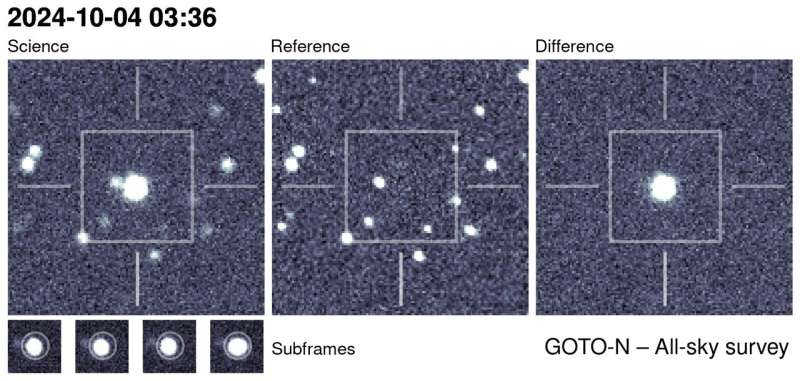
In an extraordinary achievement for citizen science, volunteers have discovered a new exploding star, named GOTO0650, through the Kilonova Seekers project. This remarkable find, announced on July 1, 2025, by the University of Warwick, was published in the journal Astronomy & Astrophysics. The discovery highlights the power of public participation in scientific research, as volunteers identified the star just 3.5 hours after the image was captured by the Gravitational-wave Optical Transient Observer (GOTO) telescopes.
Kilonova Seekers invites the public to compare recent images of the night sky with those taken previously, aiming to spot new stars or changes in light intensity. The project, which is approaching its two-year anniversary, has engaged over 3,500 members of the public in this real-time astronomical endeavor.
The Discovery of GOTO0650
GOTO0650 underwent a dramatic increase in brightness, becoming 2,500 times brighter than it appeared two days earlier. This rapid identification and classification as a cataclysmic variable star were made possible by the swift actions of Kilonova Seekers volunteers. These stars are compact binary systems where a white dwarf star accretes material from a companion star, leading to explosive outbursts.
Dr. Tom Killestein, co-lead of Kilonova Seekers and Warwick Prize Fellow, remarked on the significance of the volunteers’ contributions. “Remarkably, public volunteers identified this star as an object of interest within hours. This discovery could have been missed without their efforts,” he said.
Citizen Science: A Powerful Tool
Citizen science has proven to be a powerful tool in managing vast datasets that would otherwise overwhelm small teams of scientists. Dr. Lisa Kelsey, co-lead of Kilonova Seekers, emphasized the project’s success, stating, “With over 2.8 million classifications so far, the discovery of GOTO0650 is the pinnacle of two years of hard work from our volunteers.”
The project leverages the capabilities of the GOTO project, which captures all-sky survey images from telescopes in Spain and Australia. The involvement of citizen scientists ensures that significant astronomical events, like the discovery of GOTO0650, are not overlooked.
Personal Impact and Global Participation
Volunteers from around the world have shared their personal experiences with the project. Svetoslav Alexandrov from Bulgaria described how participating in Kilonova Seekers transformed his daily commute into a scientific endeavor. “I literally screamed with joy when I saw that I was going to be a co-author of the research paper,” he said.
Similarly, Cledison Marcos da Silva from Brazil found solace in the project during a challenging time. “This discovery shows the importance of citizen science, both scientifically and personally,” he noted.
The Future of Citizen Science in Astronomy
The success of Kilonova Seekers underscores the potential of citizen science in astronomy. With the increasing volume of data from wide-field imaging surveys, public involvement is crucial in identifying and analyzing astronomical phenomena. The project has not only facilitated significant discoveries but also fostered a global community of amateur astronomers and enthusiasts.
As the project continues, it aims to expand its reach and impact, offering more people the opportunity to contribute to groundbreaking scientific research. The discovery of GOTO0650 serves as a testament to the power of collaboration between scientists and the public, paving the way for future astronomical breakthroughs.
For more information on the discovery and the Kilonova Seekers project, the full study by T. L. Killestein et al. can be accessed in Astronomy & Astrophysics, DOI: 10.1051/0004-6361/202553823.







